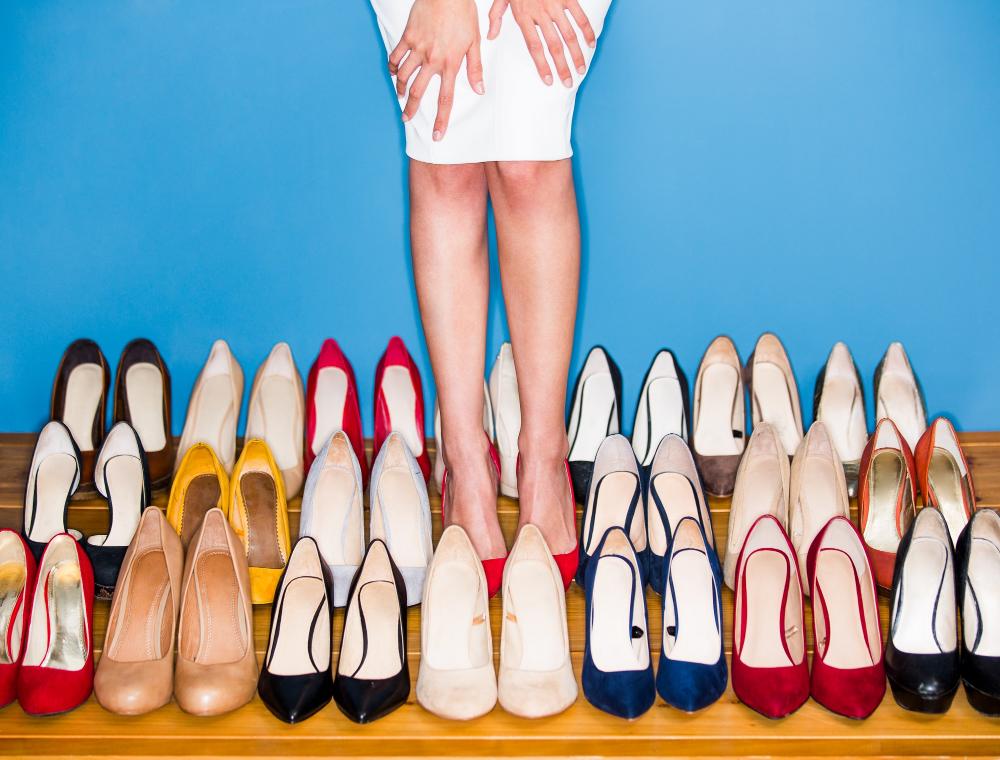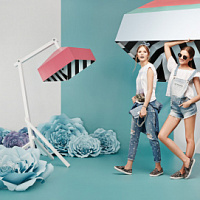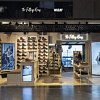 Photo: iStock
Photo: iStock
How to increase store traffic through the newsletter

“Buyers don’t come to us, what to do?” - this question was asked at least once in a lifetime by any store owner. For those who are tormented by this problem right now, we have good news: they do not come not only to you. And for those who are more concerned about what to do, we have excellent advice: stop spending money on impersonal “for everyone and anyone” mailing lists and contact customers as personally as possible. How to do this exactly, says Yulia Veshnyakova, general director of the Academy of Retail Technologies.
 Julia Veshnyakova, Director General of the consulting company Academy of Retail Technologies, practicing procurement specialist for a collection of fashionable clothes and accessories at specialized exhibitions. Practical experience in the fashion industry - 19 years.
Julia Veshnyakova, Director General of the consulting company Academy of Retail Technologies, practicing procurement specialist for a collection of fashionable clothes and accessories at specialized exhibitions. Practical experience in the fashion industry - 19 years.
Company Academy of Retail Technologies - Consulting company focused on the fashion industry and on entrepreneurs of small and medium-sized businesses. Provides counseling and business training services.
www.Article-rb.ru
Why don't they come?
“Customers are now less likely to go to the shops!” - almost all of our customers with trendy stores in Russia unanimously complain. And they are not alone in their problem: the decrease in the traffic of shopping centers, especially in the regions, decreased by 10%. “If in 2008, consumers went shopping on average 158 times, now now they go up to 144 once a year. And that number continues to fall, ”says Nielsen, a consumer research company. Analysts conclude that low attendance is related to the conviction of 72% of respondents that the crisis continues. In addition, there are other factors, for example, frightening gas prices and over-employment of people. There is also a deterioration in the financial situation of consumers: wage growth turned out to be lower than expected, and if you remember that many people still have a “sword of Damocles” in the form of monthly loan payments, then restraining the purchasing power of the population ceases to seem so unexpected.
Of course, reduced consumption is detrimental to retailers. This situation is observed not only in the fashion business. For example, X5 Retail Group, the largest player in the food retail market in Russia, has announced that this year its profit margin will be a quarter lower than planned. This means that people save not only on the purchase of clothes, shoes or accessories, but also on the purchase of products. A significant reduction in the number of shopping trips is becoming the norm, and there is nothing to be done about it - you need to somehow adapt to this situation. There is no place for the blind, deaf and dumb in business: success in retail trade strongly depends on the entrepreneur's ability to adapt to a changing external environment. In the business world, it is impossible to wait until the “normal” situation returns, because something else has already become the norm.
What to do?
To attract new customers, you need to regularly give massive advertising in all types of media and at points of sale. But advertising is expensive and troublesome, and does it make sense in terms of costs and returns for a small store? It’s quite difficult to track the effectiveness of advertising in the shoe business, because it is not always clear whether buyers came from advertisements, due to changes in the weather, or for other reasons only to them. In addition, one can evaluate the success of the action only by the result of sales, that is, it is simply impossible to know in advance if a hundred or two thousand rubles will be spent in vain. If the budget does not allow rileatherg so that later, perhaps, drink champagne, you need to look for other ways to increase sales.
It is known that retaining a regular customer is three times cheaper than attracting a new one. Therefore, working with an already developed customer base with the right approach can solve the problem of low sales. What is meant by the “right approach”? Today, an increasing trend is gaining momentum in promotion, the essence of which lies in the maximum personal appeal to each consumer. The most effective advertising on the Internet takes into account the user's search queries history and his personal data taken from social networks, and offers the potential buyer something that may suit him. Offline, personalized calls work no worse, just rarely who uses them. And this is strange, because for an address contact with a customer, the store most often has everything you need - CRM systems, discount cards, loyalty clubs and customer surveys. Unfortunately, most often store owners do not use the potential of these tools to the fullest and do not rank the customer base for specific criteria. Instead, they launch the newsletter to the entire audience at once, annoying customers and wasting their time and money in vain.
Who and how to attract?
In order not to bore customers with regular SMS messages, the main message of which can be formulated only as “come and leave us your money”, segment the audience of your store and send messages to each group that take into account its features. So your newsletter will not be so annoying, and its effectiveness will increase, because now the message will look like a real concern for the buyer. You can segment your audience by several criteria, and the CRM database program will do this automatically.
Sign one: the frequency of purchase. On this basis, all customers are divided into one-time, episodic and regular.
Disposable Customers feed only owners of train stations, wedding salons and funeral homes. For a shoe store, an attempt to make a one-time customer permanent is meaningless, because these customers will no longer appear in the store for irresistible reasons: for example, they just live in another city and ended up here by accident. However, you can get the most out of one-time customers: try increasing their check and serving them so that they talk about your store in their homeland.
Episodic Although customers live within reach, their behavior is unpredictable. Sometimes they come to you regularly, and sometimes they disappear for months, and it is not known whether they will appear again. Their inconstancy is due to the fact that they either wear shoes for a very long time, or prefer to buy it according to their mood. As a rule, it is this type of buyer who prefers to come to your store during sales or promotions, and during the high season he always asks for an additional discount and blackmails the sellers so that if they don’t give him the required discount, he will not with the foot. You need to attract occasional customers in the same ways - not costly, but convincing that it is more profitable to shop at your store. The most effective methods in this case are the cumulative discount, coupons, a gift for the purchase, the “buy one, get another free” promotion, a discount on a certain number of purchases, and others.
Regular customers unlike episodic ones, they can be predicted because they consume your goods constantly. In the field of fashion retail, getting a regular customer is quite difficult, because shoes and clothes are not indispensable goods such as bread or stationery for the office. The customer of a shoe store will be made regular only by excellent service and the exact fit of the assortment to his needs. You can keep a regular customer with concession benefits and elitist attributes, for example, inviting him to sell one day before the official start and servicing with a "golden" bonus card.
When distributing customers according to the frequency of purchases, remember that belonging to a group of episodic or regular customers does not guarantee the next purchase. This segmentation is more likely to predict the very probability of a purchase and, possibly, its approximate time.
Symptom two: purchase size. According to the size of purchases made, customers are divided into rational and VIP-customers.
Rational customers although they drop in at a store with a certain frequency, they are not inclined to leave large amounts of money, so work with them should be aimed at increasing the check. But this is a topic for a separate article. Here we only note that you need to attract rational customers to the store on the basis of what type of customers in terms of frequency of purchase they belong.
VIP clients — These are buyers who purchase goods at your store regularly for a long time. Unfortunately, they do not often please us with visits, but the amount of their purchases is always large. Therefore, when working with a VIP client, the store owner does not have the task of increasing the size of his purchase, because it is much more important to make such a client just come more often. By the way, if the VIP-client already has a discount card with the face value of 25-30%, he will be interested to know that in the period 2 weeks before the official sale he will receive another 10 or 15% in addition to his card. Do not think that such a buyer is not interested in profitable offers: if he makes enough money, this most likely means that he knows how to manage money wisely, so your “smart offers” will be close to him. In addition, referring to VIP-customers can emphasize their status. For example, one of the stores that our company advises launched a newsletter in the spirit of “Do you drive a BMW?” We have a collection of matching shoes for you. ” Of course, these messages were sent only to those who really drive a BMW and this is listed in the CRM database.
Sign Three: Age. Since the psychology of customers varies depending on age, approaches and treatment should be different. Here, however, there are no specific patterns, so I will share observations.
Young customers, which do not yet have a stable monthly income, as a rule, react poorly to stocks with the “pay and get one more” mechanics. They are already limited in funds and buy something when there is money, so they are not interested in “scraping” rubles for an additional purchase. Instead, they can be interested in the original collection for a specific occasion (graduation party, New Year's party) at a low price.
Middle-aged people each expenditure is weighed, therefore for them, on the contrary, offers of an additional purchase make sense. For example, women can be persuaded to go to the store by offering a good discount on women's shoes when buying men's shoes from a certain amount. This, at the same time, will serve as a psychological justification for the waste: they went to buy shoes for the husband, and at the same time bought several pairs for the wife.
Senior citizens Unfortunately, in most cases they do not pay attention to SMS mailing, but they are happy to read free newspapers, flyers and other accessible materials that they find in clinics, district dogs and other institutions. People aged for 60 mostly buy shoes only when the old one is worn out, so you need to work with them as episodic customers. I would also like to note that they don’t understand stocks with complex mechanics, and sometimes they don’t even know what the word “stock”, “discount” or presale means. They must be contacted using the words "discounts", "sale" and "free."
Fourth symptom: individual characteristics. Be sure to note the personal characteristics of the client in the database and do special mailing on them. For example, women with too big or too small foot sizes will come even to the edge of the city if they find out that there are several pairs of 34-35 or 41-42 pairs left there. The same applies to buyers with a wide or narrow foot and people with sore feet.
It is important to consider
How to divide customers by segments? Use the ABC analysis, which is based on the Pareto principle: 20% of customers bring 80% of profit, and all the rest - 20% of profit. By ranking your customer base, you are likely to make sure that about 20% of your customers are VIP customers, and all the rest are just rational. They, in turn, are divided into regular and episodic (one-time clients are hardly taken into account by your loyalty program). As a rule, from 30 to 40% of the base of rational customers are those who go from time to time, and from 40 to 60% are those who buy constantly in your store. You need to strive for an ideal where 50% are regular customers and 30% are episodic customers.
By dividing your customers into groups in this way, you can plan your advertising budget and determine the marginal cost of attracting a specific category of customers. The newsletter, taking into account the psychological characteristics of each group, will be more effective than the newsletter "for all and no one at the same time." Send messages to customers from each segment at least two, but no more than three times a month. You may find that the frequency of distribution has increased, but buyers will receive your advertising messages less often. In addition, the cost of each of the calls will decrease due to an individual approach that will more motivate you to come to your store.
| Please rate the article |
Materials on the topic

Coach turned to Big Data analysis and won the interest of a young audience

Working with an active audience on Telegram and VKontakte. Mistakes brands make when moving to new local social networks

Why do we need customer reviews?

How to work in VKontakte and Telegram

WhatsApp and Telegram: Business Opportunities
Popular
 Coach turned to Big Data analysis and won the interest of a young audience
American handbag brand Coach has planned the success of its Tabby model among a younger audience, Generation Z, by turning to big data analysis, abandoning traditional and analogue tools, such as human intuition or the ability of any executive to sense “which way the wind will blow,” writes B.O.F.
Coach turned to Big Data analysis and won the interest of a young audience
American handbag brand Coach has planned the success of its Tabby model among a younger audience, Generation Z, by turning to big data analysis, abandoning traditional and analogue tools, such as human intuition or the ability of any executive to sense “which way the wind will blow,” writes B.O.F.
 IDOL updates the concept
The IDOL brand, part of the Melon Fashion Group portfolio, opened the first flagship in an updated concept in the Aviapark shopping center in Moscow.
IDOL updates the concept
The IDOL brand, part of the Melon Fashion Group portfolio, opened the first flagship in an updated concept in the Aviapark shopping center in Moscow.
 Seven “sins” of the shoe business. How do owners harm the company with their own hands?
Why is Company X able to create a strong, profitable brand, but Company Y is struggling to make ends meet? Many people prefer to attribute success to luck, luck, or the support of strong patrons. And few people ask themselves the question: “What am I doing wrong?” Moreover, many entrepreneurs begin to harm their business from the first day of its opening. In this article, together with SR expert in the field of fashion business management and development, Maria Gerasimenko, we will look at the 7 main “sins” that business owners commit using specific examples.
Seven “sins” of the shoe business. How do owners harm the company with their own hands?
Why is Company X able to create a strong, profitable brand, but Company Y is struggling to make ends meet? Many people prefer to attribute success to luck, luck, or the support of strong patrons. And few people ask themselves the question: “What am I doing wrong?” Moreover, many entrepreneurs begin to harm their business from the first day of its opening. In this article, together with SR expert in the field of fashion business management and development, Maria Gerasimenko, we will look at the 7 main “sins” that business owners commit using specific examples.
 Current techniques in lighting a shoe store
Today, walking through the galleries of shopping centers, we see a variety of formats of offline stores. New concepts of retail spaces attract with an individual, memorable design. In a certain sense, they are an element of the show, a tool through which the buyer receives a new and interesting experience. Together with SR expert in the field of lighting technology in retail, Tatyana Ryzhova, we will look at current lighting design techniques for modern shoe stores, which we will see more and more often in new retail outlets in the near future.
Current techniques in lighting a shoe store
Today, walking through the galleries of shopping centers, we see a variety of formats of offline stores. New concepts of retail spaces attract with an individual, memorable design. In a certain sense, they are an element of the show, a tool through which the buyer receives a new and interesting experience. Together with SR expert in the field of lighting technology in retail, Tatyana Ryzhova, we will look at current lighting design techniques for modern shoe stores, which we will see more and more often in new retail outlets in the near future.
 Louis Vuitton opens a new factory in Italy
Louis Vuitton has opened its second shoe factory in Italy. After opening the first one in Fiesso d'Artico in Veneto, the LVMH flagship brand has just opened a new production site dedicated to this category of footwear in the industrial zone of Civitano in the Marche region. There is also another brand production facility in Tuscany, where bags and leather accessories are produced, writes fr.fashionnetwork.com.
Louis Vuitton opens a new factory in Italy
Louis Vuitton has opened its second shoe factory in Italy. After opening the first one in Fiesso d'Artico in Veneto, the LVMH flagship brand has just opened a new production site dedicated to this category of footwear in the industrial zone of Civitano in the Marche region. There is also another brand production facility in Tuscany, where bags and leather accessories are produced, writes fr.fashionnetwork.com.
 The Euro Shoes@CAF exhibition will be held in Almaty
From March 11 to 13, the Euro Shoes@CAF (Central Asia Fashion) exhibition will be held in Almaty at the Atakent exhibition complex. The exhibition, which is the largest international event in the fashion industry in Central Asia, will present collections of clothing, shoes and accessories.
The Euro Shoes@CAF exhibition will be held in Almaty
From March 11 to 13, the Euro Shoes@CAF (Central Asia Fashion) exhibition will be held in Almaty at the Atakent exhibition complex. The exhibition, which is the largest international event in the fashion industry in Central Asia, will present collections of clothing, shoes and accessories.
 Euro Shoes will start operating on February 19 in Moscow!
The winter session of the international exhibition of footwear and accessories Euro Shoes premiere collection will be held in Moscow at the Expocenter from February 19 to 22. The organizers promise the presence of all the main participants at the exhibition, as well as new names from Europe, Asia and Russia.
Euro Shoes will start operating on February 19 in Moscow!
The winter session of the international exhibition of footwear and accessories Euro Shoes premiere collection will be held in Moscow at the Expocenter from February 19 to 22. The organizers promise the presence of all the main participants at the exhibition, as well as new names from Europe, Asia and Russia.
 American buyers couldn't buy Birkin bags and sued Hermès
French fashion house Hermès is facing a lawsuit in California from two customers who were unable to purchase exclusive Birkin bags. The fashion house is accused of unfair commercial practices.
American buyers couldn't buy Birkin bags and sued Hermès
French fashion house Hermès is facing a lawsuit in California from two customers who were unable to purchase exclusive Birkin bags. The fashion house is accused of unfair commercial practices.
 Why Rendez-Vous and Yandex Lavka released a “bread bag”
Shoe retailer Rendez-Vous announced the launch of a spring collaboration with Yandex Lavka and released a roll that resembles the shape of a woman’s handbag. This “Bread Bag” is presented in the Yandex.Lavka application at a price of 249 rubles. On the product packaging there is a promotional code for 1000 rubles, which can be spent in the Rendez-Vous network.
Why Rendez-Vous and Yandex Lavka released a “bread bag”
Shoe retailer Rendez-Vous announced the launch of a spring collaboration with Yandex Lavka and released a roll that resembles the shape of a woman’s handbag. This “Bread Bag” is presented in the Yandex.Lavka application at a price of 249 rubles. On the product packaging there is a promotional code for 1000 rubles, which can be spent in the Rendez-Vous network.
 Camper has released innovative sneakers - designers
Spanish brand Camper's new Roku sneaker features six interchangeable components to create up to 64 different looks and color combinations. Roku means "six" in Japanese.
Camper has released innovative sneakers - designers
Spanish brand Camper's new Roku sneaker features six interchangeable components to create up to 64 different looks and color combinations. Roku means "six" in Japanese.
 Turkish brand Vaneda on Euro Shoes
Street style, sport, outdoor, military – the main style directions of footwear of the company from Turkey
Turkish brand Vaneda on Euro Shoes
Street style, sport, outdoor, military – the main style directions of footwear of the company from Turkey
 Christian Louboutin presented a collection in a cowboy style
At the Loubi Show in Paris, the French luxury brand Christian Louboutin presented its fall 2024 collection, following the trend - in the style of the Wild West. It included cowboy boots and rhinestone loafers.
Christian Louboutin presented a collection in a cowboy style
At the Loubi Show in Paris, the French luxury brand Christian Louboutin presented its fall 2024 collection, following the trend - in the style of the Wild West. It included cowboy boots and rhinestone loafers.
 Fashion Week takes place in Moscow
Fashion Week takes place in the Russian capital. Events include fashion shows, markets where you can purchase clothes, bags and accessories, and a B2B Showroom for fashion industry professionals.
Fashion Week takes place in Moscow
Fashion Week takes place in the Russian capital. Events include fashion shows, markets where you can purchase clothes, bags and accessories, and a B2B Showroom for fashion industry professionals.
 We are ready for active development in the Russian market
Friedrich Naumann, CEO of the Tamaris brand, told Shoes Report about the company’s ambitious plans, business development in Russia and expansion of the retail network, and also shared details about new collections and launches.
We are ready for active development in the Russian market
Friedrich Naumann, CEO of the Tamaris brand, told Shoes Report about the company’s ambitious plans, business development in Russia and expansion of the retail network, and also shared details about new collections and launches.
 Fashion trends Fall-Winter 2023/24 for commercial footwear purchases
Permanent contributor to Shoes Report. Elena Vinogradova, an expert in sales and purchases in the fashion business, prepared an overview of the trends for the autumn-winter 2023/24 season especially for us.
Fashion trends Fall-Winter 2023/24 for commercial footwear purchases
Permanent contributor to Shoes Report. Elena Vinogradova, an expert in sales and purchases in the fashion business, prepared an overview of the trends for the autumn-winter 2023/24 season especially for us.
 MSCHF and Crocs launch "Big Yellow Boots"
Creator of the Big Red Boots, Brooklyn brand MSCHF has teamed up with American plastic clog and sandal brand Crocs for another oversized shoe. The new Big Yellow Boots will go on sale on August 9th.
MSCHF and Crocs launch "Big Yellow Boots"
Creator of the Big Red Boots, Brooklyn brand MSCHF has teamed up with American plastic clog and sandal brand Crocs for another oversized shoe. The new Big Yellow Boots will go on sale on August 9th.
 Five rules of professional lighting for a shoe store - something that is relevant in any season
When developing a lighting concept for shoe retailers, it is important to take into account not only the history of the brand, the architectural content of the premises, the target audience of the stores, but also the seasonality of the goods. With the onset of the cold season, client preferences change: bright weightless shoes are replaced by more massive models in discreet dark colors. Despite significant differences in summer and winter collections, the overall philosophy of the brand, its recognition should remain unchanged at any time of the year. Tatyana Ryzhova, an SR lighting expert in fashion retail, has identified five basic rules for a competent lighting concept for a shoe store for readers of the magazine, which will help to present winter assortment to customers in a winning way.
Five rules of professional lighting for a shoe store - something that is relevant in any season
When developing a lighting concept for shoe retailers, it is important to take into account not only the history of the brand, the architectural content of the premises, the target audience of the stores, but also the seasonality of the goods. With the onset of the cold season, client preferences change: bright weightless shoes are replaced by more massive models in discreet dark colors. Despite significant differences in summer and winter collections, the overall philosophy of the brand, its recognition should remain unchanged at any time of the year. Tatyana Ryzhova, an SR lighting expert in fashion retail, has identified five basic rules for a competent lighting concept for a shoe store for readers of the magazine, which will help to present winter assortment to customers in a winning way.
 I doubt and object: how to find an approach to difficult clients?
How good and serene would be the work of a salesperson if the customers were calm, cheerful, always knew exactly what they wanted, and bought, bought, bought! It is a pity that this is possible only in dreams. Therefore, we will not dream, but we will act. Together with Maria Gerasimenko, a permanent author of SR, we understand the doubts and objections of buyers and build a strategy for working with them. Our expert pays special attention to the two main objections of buyers, on which 82% of sales are lost.
I doubt and object: how to find an approach to difficult clients?
How good and serene would be the work of a salesperson if the customers were calm, cheerful, always knew exactly what they wanted, and bought, bought, bought! It is a pity that this is possible only in dreams. Therefore, we will not dream, but we will act. Together with Maria Gerasimenko, a permanent author of SR, we understand the doubts and objections of buyers and build a strategy for working with them. Our expert pays special attention to the two main objections of buyers, on which 82% of sales are lost.
 EURO SHOES presents an updated section of the GLOBAL SHOES exhibition with collections of shoe and bag brands from Asian countries
EURO SHOES premiere collection is expanding. Along with the traditional pool of leading European footwear brands from Germany, Spain, Italy and Turkey, several dozen footwear and bag brands from the Middle Kingdom will be presented in the GLOBAL SHOES section at the Moscow Expocentre from August 29 to September 1.
EURO SHOES presents an updated section of the GLOBAL SHOES exhibition with collections of shoe and bag brands from Asian countries
EURO SHOES premiere collection is expanding. Along with the traditional pool of leading European footwear brands from Germany, Spain, Italy and Turkey, several dozen footwear and bag brands from the Middle Kingdom will be presented in the GLOBAL SHOES section at the Moscow Expocentre from August 29 to September 1.
 World Footwear Yearbook: Global footwear production reaches 23,9 billion pairs and is back to pre-pandemic levels
The Portuguese association of shoe manufacturers APICCAPS published the 13th edition of the international statistical bulletin World Footwear Yearbook for 2023, according to which in 2022 the production and export of shoes worldwide increased by 7,6% and 9%, respectively, and the world production of shoes reached 23,9 billion couples and returned to pre-pandemic levels.
World Footwear Yearbook: Global footwear production reaches 23,9 billion pairs and is back to pre-pandemic levels
The Portuguese association of shoe manufacturers APICCAPS published the 13th edition of the international statistical bulletin World Footwear Yearbook for 2023, according to which in 2022 the production and export of shoes worldwide increased by 7,6% and 9%, respectively, and the world production of shoes reached 23,9 billion couples and returned to pre-pandemic levels.
 Rostov footwear brand Novak presented a collection of sneakers and sneakers
In the spring-summer 2023 season, the Rostov-on-Don shoe brand Novak presented a cute collection of sneakers and sneakers for every day. The upper of the shoe is made of genuine leather, suede, nubuck, the sole is made of light EVA.
Rostov footwear brand Novak presented a collection of sneakers and sneakers
In the spring-summer 2023 season, the Rostov-on-Don shoe brand Novak presented a cute collection of sneakers and sneakers for every day. The upper of the shoe is made of genuine leather, suede, nubuck, the sole is made of light EVA.
 Jacquemus x Nike collaboration released
The second collaboration between Jacquemus and Nike, which has been talked about so much, is finally out. The appearance of the couple for many was a surprise. The model of Nike Air Force 1 sneakers, which was taken as the basis of the new collection, has undergone significant changes.
Jacquemus x Nike collaboration released
The second collaboration between Jacquemus and Nike, which has been talked about so much, is finally out. The appearance of the couple for many was a surprise. The model of Nike Air Force 1 sneakers, which was taken as the basis of the new collection, has undergone significant changes.
 Crocs releases a collaboration with Barbie
If Barbie ditched heels and wore crocs, they would be pink. It was this collection in pink that was released by the American brand of plastic clogs Crocs, for the release of the film "Barbie" in the United States.
Crocs releases a collaboration with Barbie
If Barbie ditched heels and wore crocs, they would be pink. It was this collection in pink that was released by the American brand of plastic clogs Crocs, for the release of the film "Barbie" in the United States.
 Japanese BAPE takes to the catwalk MSCHF Big Red Boots
The story of Brooklyn brand MSCHF's oversized rubber boots continues. The last time they made noise in the auditorium was at the Rick Owens menswear show. Now they have already appeared on the podium.
Japanese BAPE takes to the catwalk MSCHF Big Red Boots
The story of Brooklyn brand MSCHF's oversized rubber boots continues. The last time they made noise in the auditorium was at the Rick Owens menswear show. Now they have already appeared on the podium.
 Shoe educational program: what shoe soles are made of
“What is the difference between TEP and EVA? What does tunit promise me? Is PVC glue? What is the sole of these shoes made of? ”- the modern buyer wants to know everything. In order not to smash his face in front of him and be able to explain whether such a sole suits him in soles, carefully read this article. In it, process engineer Igor Okorokov tells what materials the soles of shoes are made of and what makes each of them so good.
Shoe educational program: what shoe soles are made of
“What is the difference between TEP and EVA? What does tunit promise me? Is PVC glue? What is the sole of these shoes made of? ”- the modern buyer wants to know everything. In order not to smash his face in front of him and be able to explain whether such a sole suits him in soles, carefully read this article. In it, process engineer Igor Okorokov tells what materials the soles of shoes are made of and what makes each of them so good.
 How to set prices that will earn
Some businessmen still confuse the concept of margin with the concept of trade margins and set prices for their goods, guided solely by the example of competitors. No wonder they go broke! Analyst at the Academy of Retail Technologies Maxim Gorshkov gives several tips and formulas with which you can set not only ruinous, but also profitable prices.
How to set prices that will earn
Some businessmen still confuse the concept of margin with the concept of trade margins and set prices for their goods, guided solely by the example of competitors. No wonder they go broke! Analyst at the Academy of Retail Technologies Maxim Gorshkov gives several tips and formulas with which you can set not only ruinous, but also profitable prices.
 Sales of shoes and accessories: effective techniques for business rhetoric
Which speech modules are effective in communicating with potential and current customers of shoe stores, and which are not, Anna Bocharova, a business consultant, knows.
Sales of shoes and accessories: effective techniques for business rhetoric
Which speech modules are effective in communicating with potential and current customers of shoe stores, and which are not, Anna Bocharova, a business consultant, knows.
 We form the salary of sellers: expert advice
“How do you charge your consultants for personal or general sales?” Is one of the most popular questions causing a lot of controversy and gossip on the online forums of retail business owners. Indeed, how to properly form the earnings of sellers? But what about bonuses, where to get a sales plan from, do employees allow them to buy goods at discounted stores? In search of truth, the Shoes Report turned to a dozen shoe retailers, but no company wanted to disclose its motivation system - the process of its development was too complicated and individual. Then we asked four business consultants, and finally became convinced that the topic of seller motivation is very complex, because even our experts could not come to a common opinion.
We form the salary of sellers: expert advice
“How do you charge your consultants for personal or general sales?” Is one of the most popular questions causing a lot of controversy and gossip on the online forums of retail business owners. Indeed, how to properly form the earnings of sellers? But what about bonuses, where to get a sales plan from, do employees allow them to buy goods at discounted stores? In search of truth, the Shoes Report turned to a dozen shoe retailers, but no company wanted to disclose its motivation system - the process of its development was too complicated and individual. Then we asked four business consultants, and finally became convinced that the topic of seller motivation is very complex, because even our experts could not come to a common opinion.
 Technology Selling Issues
There is nothing worse than meeting the buyer with the words “Hello, can I help you with something?”, Because the seller works in the store just to help. Criticizing this well-established pattern of communication with the buyer, Andrei Chirkarev, business coach for effective sales and the founder of the New Economy project, shares the technology of truly selling issues with readers of Shoes Report.
Technology Selling Issues
There is nothing worse than meeting the buyer with the words “Hello, can I help you with something?”, Because the seller works in the store just to help. Criticizing this well-established pattern of communication with the buyer, Andrei Chirkarev, business coach for effective sales and the founder of the New Economy project, shares the technology of truly selling issues with readers of Shoes Report.
 The whole truth about Bayer. Who is he and how to become one?
Bayer is no longer a new, but still a popular and sought-after profession. It’s fashionable to be a buyer. Buyers are at the origins of the emergence and development of trends. If the designer offers his vision of fashion in the season, then the buyer selects the most interesting commercial ideas. It is on buyers that the policy of sales of stores and what, in the end, the buyer will wear depends on. This profession is surrounded by a magical fleur, often associated with a lack of understanding of what exactly is the work of a buyer.
The whole truth about Bayer. Who is he and how to become one?
Bayer is no longer a new, but still a popular and sought-after profession. It’s fashionable to be a buyer. Buyers are at the origins of the emergence and development of trends. If the designer offers his vision of fashion in the season, then the buyer selects the most interesting commercial ideas. It is on buyers that the policy of sales of stores and what, in the end, the buyer will wear depends on. This profession is surrounded by a magical fleur, often associated with a lack of understanding of what exactly is the work of a buyer.
 Fur, and not only: types of lining
In the production of winter footwear, various materials are used that are designed to retain heat and meet the requirements of consumers: natural sheepleather, artificial fur, artificial fur from natural wool and others. All types of lining fur have their own advantages and disadvantages. Let's consider the properties of each of them.
Fur, and not only: types of lining
In the production of winter footwear, various materials are used that are designed to retain heat and meet the requirements of consumers: natural sheepleather, artificial fur, artificial fur from natural wool and others. All types of lining fur have their own advantages and disadvantages. Let's consider the properties of each of them.
 Retail Arithmetic
Before you begin to solve specific problems, you need to find out how accurately all the leaders of your company understand the basic terminology of retail.
Retail Arithmetic
Before you begin to solve specific problems, you need to find out how accurately all the leaders of your company understand the basic terminology of retail.
 How to fire a worker without tears, scandal and trial
Sooner or later, any manager is faced with the need to part with an employee. Properly and on time the dismissal procedure will save the company money, and the boss himself - nerves and time. But why sometimes, knowing that a break in relations is inevitable, we put off the decision for months?
How to fire a worker without tears, scandal and trial
Sooner or later, any manager is faced with the need to part with an employee. Properly and on time the dismissal procedure will save the company money, and the boss himself - nerves and time. But why sometimes, knowing that a break in relations is inevitable, we put off the decision for months?






